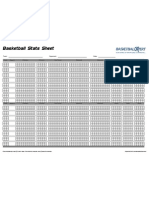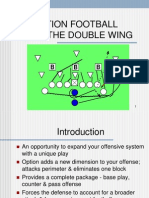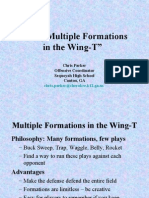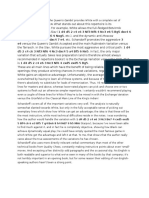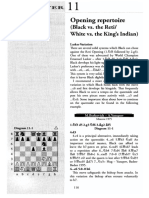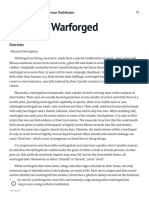Ebcafe 08
Ebcafe 08
Uploaded by
dassdfdsfCopyright:
Available Formats
Ebcafe 08
Ebcafe 08
Uploaded by
dassdfdsfOriginal Title
Copyright
Available Formats
Share this document
Did you find this document useful?
Is this content inappropriate?
Copyright:
Available Formats
Ebcafe 08
Ebcafe 08
Uploaded by
dassdfdsfCopyright:
Available Formats
Everyman
Ebook Cafe
Translate this page
Slay the Sicilian!
by Timothy Taylor
I was idly looking at World Champion Anatoly Karpov's book, My Best
Games and I came across a line that absolutely stunned me, that I quote in
full below:
"I have always felt it completely unnecessary for White to rush
headlong into a maelstrom of forced variations with his first moves in
the Sicilian. His superiority in the centre gives him the possibility of
resolving any problem by solid positional play."
While I have always admired Karpov's positional play and his relentless
technique, I've never been a fan in the way I am a fan of the wizard of Riga.
But after being rescued from a desperate situation, I not only became a big
fan, I have made Karpov (like Keres in Slay the Spanish) the hero of this
entire book!
I found Karpov's repertoire to be amazingly human and easy to learn and
absolutely deadly over the board. It seems that no one really plays this way
anymore instead everyone is out there with their laptops rushing headlong
into that "maelstrom of forced variations". Thus virtually none of the
opponents I encountered were prepared for what I would describe as solid
positional play with a drop of poison. However (I couldn't help myself!),
against the Dragon I also offer an alternative, non-Karpovian method, the
Alekhine Attack, which so suited my style I barely had to study it!
In any case, each chapter starts with a Karpov game, and then continues with
relevant games from renowned GMs and World Champions, as well as a
number of my own efforts from the trenches.
Let's take a look at this repertoire, which I stress is easy to learn and very
very effective. The Sicilian naturally divides into six types of opening,
according to pawn structure, represented by the first six chapters of this book,
with a seventh "catch all" chapter devoted to unusual odds and ends.
Taylor, T Gutman, J
SCCF Championship, Los Angeles, 2011
Sicilian Defence [B58]
1.e4 c5 2.Nf3 d6 3.d4 cxd4 4.Nxd4 Nf6 5.Nc3 Nc6 6.Be2 e5 7.Nf3
I considered playing Louma's 7.Nxc6, but I thought I might never get another
6...e5, so I should play the objectively best move.
7...Be7
And was immediately rewarded! People don't know their Boleslavsky!
8.Bg5 Be6 9.0-0 a6
If 9...0-0, I was ready with 10.a3!.
Purchases from our
chess shop help keep
ChessCafe.com freely
accessible:
True Combat Chess
by Timothy Taylor
The Dark Knight System
by J ames Schuyler
Chess Strategy:
Move by Move
by Adam Hunt
10.Bxf6 Bxf6 11.Nd5
[FEN "r2qk2r/1p3ppp/p1npbb2/3Np3/4P3/
5N2/PPP1BPPP/R2Q1RK1 b kq - 0 11"]
White has conquered d5 and one can't see anything Black got out of it: the
white knight looks better than both black bishops!
11...Ne7
So Black tries to get rid of it!
If instead 11...0-0, then 12.Nxf6+(12.c3 is possible with a typical plus-equals
squeeze position) 12...Qxf6 (12...gxf6 is ugly but necessary) 13.Qxd6 Qf4
14.Rfe1 and no compensation for the pawn can be found, as 14...Qxe4 fails to
15.Bxa6.; Another try is 11...Bxd5 12.Qxd5 Qc7 13.c3 0-0 14.Nd2 Rad8
15.Bf3 Bg5 16.Rfd1, but then White had the typical annoying pull with Black
having no compensation for the weaknesses at d5 and d6 White converted in
36 moves in W.Kobese-Cho.Stanley, African Championship, Cairo 1998.
12.Nxf6+ gxf6
[FEN "r2qk2r/1p2np1p/p2pbp2/4p3/4P3/
5N2/PPP1BPPP/R2Q1RK1 w kq - 0 13"]
13.Qd2
I spotlight the pawns at d6 and f6.
13...Qc7
Black can't free himself: 13...d5 14.Qh6! dxe4 15.Rad1 Nd5 (or 15...Qc7
16.Qxf6 with destruction) 16.c4! exf3 17.Bxf3 and White recovers his piece
with an overwhelming positional advantage, as Black is unlikely ever to
castle in this game.
14.Rfd1 Rd8
14...0-0-0 is relatively best, but after 15.c4 White has locked down d5 and
retains the safer king.
15.c4!
[FEN "3rk2r/1pq1np1p/p2pbp2/4p3/2P1P3/
5N2/PP1QBPPP/R2R2K1 b k - 0 15"]
Since the c-pawn is immune, Black will not be getting...d6-d5 in any time
soon!
15...Ng6 16.Rac1 Rd7 17.g3 h5 18.h4 f5 19.Ng5
Perhaps 19.exf5 Bxf5 20.Re1 Rg8 21.Ng5 f6 22.Qd5 is simpler, when Black's
position is full of holes.
19...f4 20.Nxe6 fxe6 21.Rc3
Another way is 21.c5 dxc5 22.Qxd7+Qxd7 23.Rxd7 Kxd7 24.Rxc5 Kd6
25.Rc3 with a big endgame plus, but I wanted to "Fracture him!" Fischer-
style in the middlegame.
21...Qc5 22.Kg2 fxg3
22...Ke7 is necessary, but White follows with something like Bf3 and a2-
a3/b2-b4 ultimately Black is fighting a losing battle, in view of his
weaknesses at d6 and h5 and unsafe king in the middle.
23.fxg3 Rg7 24.Qxd6!
[FEN "4k2r/1p4r1/p2Qp1n1/2q1p2p/2P1P2P/
2R3P1/PP2B1K1/3R4 b k - 0 24"]
24...Qxd6
White refutes the demonstration 24...Nxh4+25.Kh3 Qf2 with 26.Bxh5+!
Rxh5 27.Qxe6+Re7 (27...Kf8 28.Rd8#is drastic) 28.Qg8+Qf8 29.Rd8+
Kxd8 30.Qxf8+, winning the queen.
25.Rxd6
So I got an ending after all but Black's pawns are so weak, there is no doubt
White has a winning position.
25...Ke7
The same counter also fails here: 25...Nxh4+26.Kh3 Ng6 27.Rcd3!, when
White forces the exchange of rooks and wins cleanly; e.g. 27...Rh6 28.Rd8+
Ke7 29.R3d7+Kf6 30.Rxg7 Kxg7 31.Rd7+etc.
26.Rb6 Nf4+ 27.Kf1
27.Kf3? Rxg3+was evidently Black's hope.
27...Nxe2 28.Kxe2 Kf6
The simple variation 28...Rb8 29.Rcb3 Kf6 30.c5 Rc7 31.c6 demonstrates that
Black's position is indefensible.
29.Rf3+ 1-0
Pawns start dropping, the first with check.
The main thing I learned from writing this book is that the Sicilian's
reputation is far greater than its actual danger. You hear all this nonsense
about how you have to be booked up thirty moves, and all the top players
have everything memorized, so it's far too risky to play the Open Sicilian; you
should play it safe with the Closed and hope for an equal position and yet
that image of the Sicilian as some monstrous Hydra is simply not true.
For one thing, if the monster existed in reality as opposed to reputation, I
certainly would never have scored 71% against higher-rated opposition!
Moving up the scale, Karpov would never have scored like he did recall that
he never, ever lost in the 6 Be2 e5 Najdorf, while playing the best in the
world and using the same line over and over. According to "Sicilian
reputation" he would have lost to some "forced variation" somewhere along
the road but that never happened, because the Be2 line does not lead to
forced variations!
Yes, there are "memory variations" in many lines of the Sicilian, but it's easy
to avoid them, as my recommended repertoire does. And when I played this
way, I found that my opponents (who wore out their brains learning lines I
did not play) were disoriented by the fact that they had to think with their own
head, and could not rely on forced computer-generated variations. At that
point, usually half the battle was won, and I could (most of the time at least!)
take care of the other half.
Order Slay the Sicilian! (Ebook)
by Timothy Taylor
Order Slay the Sicilian!
by Timothy Taylor
A PDF file of this month's column, along with all previous columns, is
available in the ChessCafe.com Archives.
Comment on this month's column via our official Chess Blog!
[ChessCafe Home Page] [ChessCafe Shop] [ChessCafe Blog]
[Book Review] [Columnists] [Endgame Study] [The Skittles Room]
[ChessCafe Links] [ChessCafe Archives]
[About ChessCafe.com] [Contact ChessCafe.com] [Advertising]
2013 BrainGamz, Inc. All Rights Reserved.
"ChessCafe.com" is a registered trademark of BrainGamz, Inc.
You might also like
- The London System in 12 Practical Lessons: Strategic Concepts, Typical Plans and Tactical ThemesFrom EverandThe London System in 12 Practical Lessons: Strategic Concepts, Typical Plans and Tactical ThemesRating: 5 out of 5 stars5/5 (2)
- Macchiato MonstersDocument60 pagesMacchiato MonstersJosephLouisNadeau80% (5)
- Chess Training For Budding ChampionsDocument4 pagesChess Training For Budding Championsradovanb50% (2)
- Basketball Stat SheetDocument1 pageBasketball Stat SheetBule BuleNo ratings yet
- Double Wing Option - Malcolm RobinsonDocument65 pagesDouble Wing Option - Malcolm RobinsonDaniel'Gettin It Done'MalcolmNo ratings yet
- 1 4909238204483239997 PDFDocument223 pages1 4909238204483239997 PDFJorge Mendez78% (9)
- S. Bücker & C. Galofre - Chess Cafe - Over The Horizons - 1-74Document599 pagesS. Bücker & C. Galofre - Chess Cafe - Over The Horizons - 1-74Paulino Aguilera Malagón100% (3)
- Beliavsky & Mikhalchishin - Winning Endgame StrategyDocument207 pagesBeliavsky & Mikhalchishin - Winning Endgame StrategyRATHEESH P.K100% (6)
- Learn All About Soccer - Activity Book Sample PagesDocument9 pagesLearn All About Soccer - Activity Book Sample PagesRandom House of CanadaNo ratings yet
- Cardus, Neville - Days in The Sun PDFDocument256 pagesCardus, Neville - Days in The Sun PDFmozam haq100% (1)
- Using Multiple Formations in The Wing-TDocument17 pagesUsing Multiple Formations in The Wing-Tcoachrji67% (6)
- Dvoretsky 126Document7 pagesDvoretsky 126mjhermanNo ratings yet
- The Panov Botvinnik Attack Move Move Lorin DCosta 3Document222 pagesThe Panov Botvinnik Attack Move Move Lorin DCosta 3Peter John Bolgert100% (4)
- Killer SicilianDocument18 pagesKiller SicilianMateusz Domusa100% (2)
- Sicilian Najdorf (English Attack 6... Ng4)Document9 pagesSicilian Najdorf (English Attack 6... Ng4)Mt's Rodrigo100% (1)
- Vola 10 Khalifman - Opening - For - White - Accordin PDFDocument194 pagesVola 10 Khalifman - Opening - For - White - Accordin PDFAbel Meza MMaNo ratings yet
- Alekhine With 4.a4 PDFDocument16 pagesAlekhine With 4.a4 PDFrubenkeller5204100% (1)
- French DefenceDocument5 pagesFrench DefencesureesicNo ratings yet
- Opening For White According To Anand 1.e4 Vol.11Document445 pagesOpening For White According To Anand 1.e4 Vol.11Jesus Manzano Barquilla100% (3)
- Sicilian O'Kelly VariationDocument21 pagesSicilian O'Kelly VariationJuan Andres Auernheimer100% (2)
- The Cambridge Springs-Panczyk & Ilczuk PDFDocument194 pagesThe Cambridge Springs-Panczyk & Ilczuk PDFMinas StoufisNo ratings yet
- New Look at The TaylerDocument14 pagesNew Look at The TaylerDavid Kane100% (1)
- King's Kalashnikov Sicilian: A Dynamic Black Repertoire for Club PlayersFrom EverandKing's Kalashnikov Sicilian: A Dynamic Black Repertoire for Club PlayersNo ratings yet
- Chess KarpovDocument9 pagesChess KarpovMasagus Sapta RyandaNo ratings yet
- Dvoretsky (Trap 1) PDFDocument10 pagesDvoretsky (Trap 1) PDFJude-lo AranaydoNo ratings yet
- ChessDocument244 pagesChessAnthony GuerraNo ratings yet
- Week in Chess Book Extracts Nov 11'13Document60 pagesWeek in Chess Book Extracts Nov 11'13Jagannathan GNo ratings yet
- ChessDocument244 pagesChessago177100% (6)
- Defensa Francesa CompletaDocument274 pagesDefensa Francesa Completayoel cuadrosNo ratings yet
- Jiganchine Roman The Break Learn From Schlechter Botvinnik ADocument224 pagesJiganchine Roman The Break Learn From Schlechter Botvinnik ADamirDesevac100% (1)
- Scacchi - (Chess) Unorthodox Openings Newsletter 11Document50 pagesScacchi - (Chess) Unorthodox Openings Newsletter 11japov100% (2)
- English Attack - de Firmian & FedorowiczDocument258 pagesEnglish Attack - de Firmian & Fedorowiczcarlosdavisora100% (1)
- 7 Ways of ScicilianDocument190 pages7 Ways of ScicilianUnknown SomeoneNo ratings yet
- Taylor Timothy - Pawn Sacrifice - Winning at Chess The Adventurous Way, 2008-OCR, Everyman, 241pDocument241 pagesTaylor Timothy - Pawn Sacrifice - Winning at Chess The Adventurous Way, 2008-OCR, Everyman, 241pJamie Steiner100% (5)
- The Scandinavian Defence: Winning with 2...Nf6: A Chess Repertoire for BlackFrom EverandThe Scandinavian Defence: Winning with 2...Nf6: A Chess Repertoire for BlackNo ratings yet
- Vs Reti Vs India de Rey From Yusupov Chess Evolution 2Document14 pagesVs Reti Vs India de Rey From Yusupov Chess Evolution 2Nicolás Riquelme AbuffonNo ratings yet
- Palkovi Joszef - Hedgehog System Against The English Opening 1997 PDFDocument132 pagesPalkovi Joszef - Hedgehog System Against The English Opening 1997 PDFMayara JulianNo ratings yet
- Martin - Scandinavian SurpriseDocument11 pagesMartin - Scandinavian Surpriseanon-355439100% (2)
- Neil McDonald - Master Class - Typical MistakesDocument16 pagesNeil McDonald - Master Class - Typical MistakeskarahmanNo ratings yet
- Kallai G. - Basic Chess Openings - 2 Closed Games (Everyman 2000)Document160 pagesKallai G. - Basic Chess Openings - 2 Closed Games (Everyman 2000)Willy Martinez100% (1)
- Donaldson John - Inside Chess Openings - King's Indian Defense - Bayonet Attack, 1996-OCR, ChessEnterprises, 126pDocument126 pagesDonaldson John - Inside Chess Openings - King's Indian Defense - Bayonet Attack, 1996-OCR, ChessEnterprises, 126panisNo ratings yet
- Modern Chess Preparation Part 6Document31 pagesModern Chess Preparation Part 6Said Alauddeen Faisz0% (1)
- 02 - Estudio - Casero - A56 - Con 3... Ce4 - (MF - Job - Sepulveda) PDFDocument57 pages02 - Estudio - Casero - A56 - Con 3... Ce4 - (MF - Job - Sepulveda) PDFpelikanero100% (2)
- Najdorf Sicilian Analysis CenterDocument4 pagesNajdorf Sicilian Analysis Centernikhil4tp100% (2)
- The Slav For The Tournament Player (Tournament Player's Repertoire of Openings)Document161 pagesThe Slav For The Tournament Player (Tournament Player's Repertoire of Openings)Ryan Padiernos67% (3)
- The Instructor: Opening CatastrophesDocument9 pagesThe Instructor: Opening CatastrophesFuad AkbarNo ratings yet
- Active Against CatalanDocument7 pagesActive Against CatalanZisisNo ratings yet
- Attacking 1... d5 - Kiril GeorgievDocument344 pagesAttacking 1... d5 - Kiril GeorgievMomin Fayzan100% (8)
- Opening For White According To Anand 1.e4, Vol. 5Document258 pagesOpening For White According To Anand 1.e4, Vol. 5bawcock80% (5)
- Spanish Opening Strategy and Tactics - Roman JiganchineDocument115 pagesSpanish Opening Strategy and Tactics - Roman JiganchineDavid Franco75% (4)
- Carlsen's Neo-Møller: A Complete and Surprising Repertoire against the Ruy LopezFrom EverandCarlsen's Neo-Møller: A Complete and Surprising Repertoire against the Ruy LopezNo ratings yet
- Chess Evolution No.181Document34 pagesChess Evolution No.181Alexandre AtlasNo ratings yet
- NoteboomDocument57 pagesNoteboomapi-272755084100% (2)
- The Slav - SadlerDocument146 pagesThe Slav - SadlerGilles Moreau90% (10)
- 100leko PDFDocument11 pages100leko PDFccKhaled2No ratings yet
- Ivans Chess Journey Games and Stories by Ivan Sokolov - PDF RoomDocument17 pagesIvans Chess Journey Games and Stories by Ivan Sokolov - PDF Roomlockpick54No ratings yet
- Opening Repertoire Najdorf ExtractsDocument25 pagesOpening Repertoire Najdorf Extractsahmed.g.fayadNo ratings yet
- French DefenceDocument16 pagesFrench Defencesujaramu100% (1)
- The Open Spanish (gnv64) PDFDocument162 pagesThe Open Spanish (gnv64) PDFioangely100% (3)
- McDonald - SO. 1 E4 A Reliable Repertoire For The Improving Player (2006)Document201 pagesMcDonald - SO. 1 E4 A Reliable Repertoire For The Improving Player (2006)bani100100% (8)
- Variant Chess Newsletter 06 PDFDocument16 pagesVariant Chess Newsletter 06 PDFRobert McCordNo ratings yet
- Andrew Martin - Scandinavian Surprise (TWIC Theory - 1)Document11 pagesAndrew Martin - Scandinavian Surprise (TWIC Theory - 1)beetletremembe100% (1)
- The Pawn CenterDocument16 pagesThe Pawn CentersunivaguNo ratings yet
- S3 Rules Sheet 02 EngDocument1 pageS3 Rules Sheet 02 EngDaniel NgNo ratings yet
- The Slayer's Guide To DragonsDocument138 pagesThe Slayer's Guide To Dragonsburtron100% (5)
- Do Violent Video Games Contribute To Youth ViolenceDocument3 pagesDo Violent Video Games Contribute To Youth ViolenceAna RodriguezNo ratings yet
- d20 Bastion Press VillainsDocument110 pagesd20 Bastion Press VillainsKyle SuttonNo ratings yet
- 1 Running and Passing SupportDocument4 pages1 Running and Passing Supporttudor raduNo ratings yet
- Eberron Pathfinder - WarforgedDocument12 pagesEberron Pathfinder - WarforgedTony Holcomb100% (1)
- Xbox-360 CompressDocument8 pagesXbox-360 CompressSamiz ChavexNo ratings yet
- Vancian Magic in World TreeDocument2 pagesVancian Magic in World TreeDanis7No ratings yet
- Kislevites: The Land of The Great BearDocument6 pagesKislevites: The Land of The Great BearJDMarkson100% (1)
- Priyanka ProjectDocument1 pagePriyanka ProjectPriyanka DeshpandeNo ratings yet
- Event PlanningDocument9 pagesEvent Planningcharlyneabay8No ratings yet
- Fighting Type Pokémon Pokémon DatabaseDocument1 pageFighting Type Pokémon Pokémon DatabaseSri WahyuniNo ratings yet
- Year Levels Timetables 2019Document12 pagesYear Levels Timetables 2019Chestha KundanNo ratings yet
- (10 Years Old) ( 5) (4) (22) (14) (16) (8 CM)Document2 pages(10 Years Old) ( 5) (4) (22) (14) (16) (8 CM)tempoNo ratings yet
- Notes - Beneath The Twisted TowerDocument32 pagesNotes - Beneath The Twisted TowerBruno BanzoNo ratings yet
- Pogonlomboy, Mangatarem, Pangasinan Mobile No.: 0920-964-4762 Name of Student: Year Level: Section: Teacher: Carl Gerard Torres Cruz, LPTDocument5 pagesPogonlomboy, Mangatarem, Pangasinan Mobile No.: 0920-964-4762 Name of Student: Year Level: Section: Teacher: Carl Gerard Torres Cruz, LPTLaarni Ariaga ToleteNo ratings yet
- 1877477-Esteemed House of CatsDocument13 pages1877477-Esteemed House of CatsDaveDMNo ratings yet
- Territorial Jurisdiction of Civil Courts in Nalgonda DistrictDocument6 pagesTerritorial Jurisdiction of Civil Courts in Nalgonda DistrictPhani Raj MNo ratings yet
- Physical Education Assignment.Document12 pagesPhysical Education Assignment.Haruka NanaseNo ratings yet
- Dodgeball Deed Registration Form (Team Sign Up)Document2 pagesDodgeball Deed Registration Form (Team Sign Up)lpolin2No ratings yet
- 7 Voyages of Zylarthen v3 Book of MagicDocument66 pages7 Voyages of Zylarthen v3 Book of MagicChaosGate5100% (3)
- Sports WritingDocument28 pagesSports WritingYuan PuntoNo ratings yet
- Wasabi 360 Ultra X360Phat Installation Guide v1.1Document11 pagesWasabi 360 Ultra X360Phat Installation Guide v1.1AzureusPTNo ratings yet



